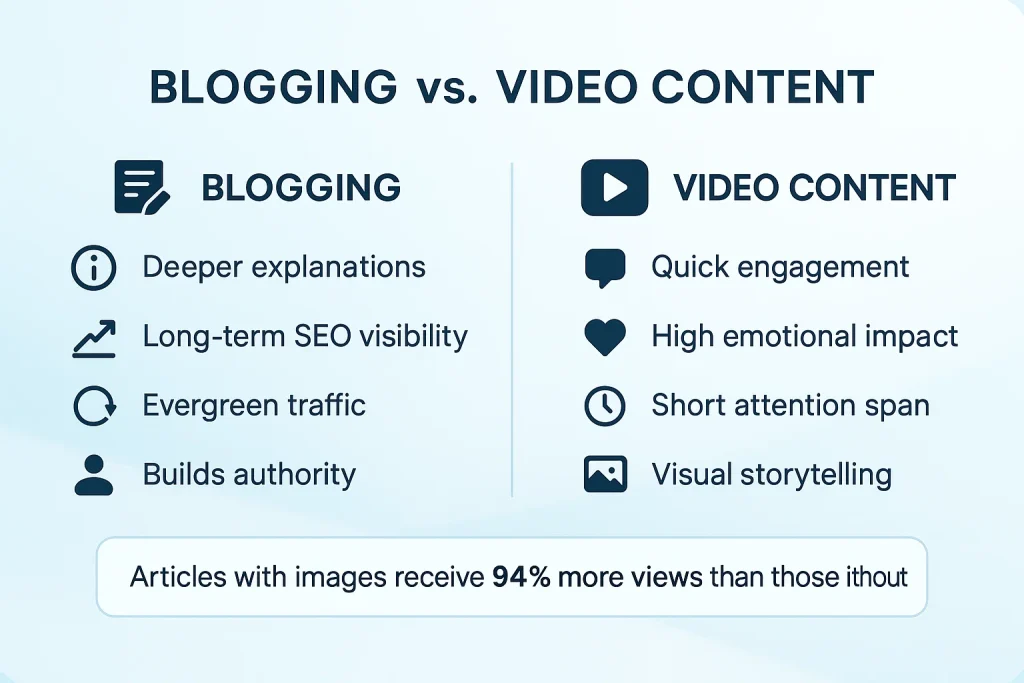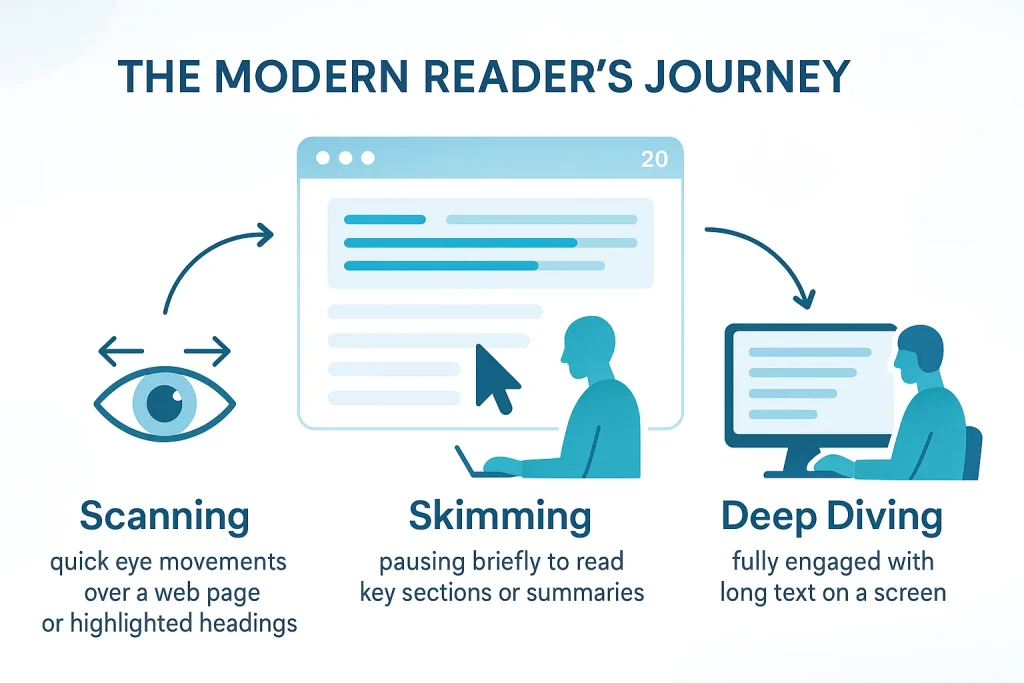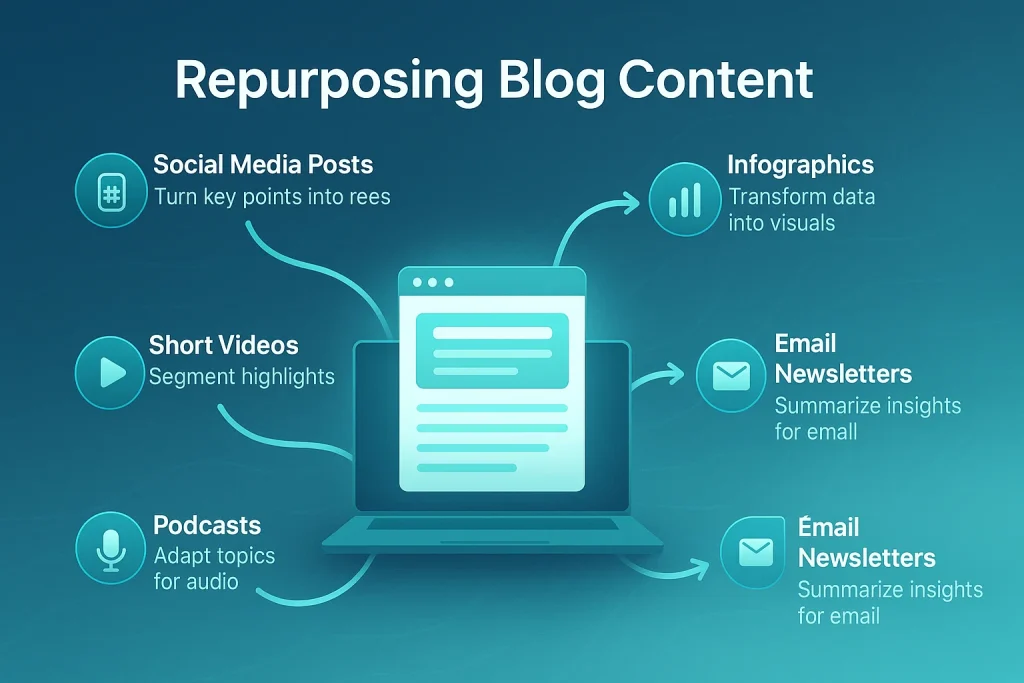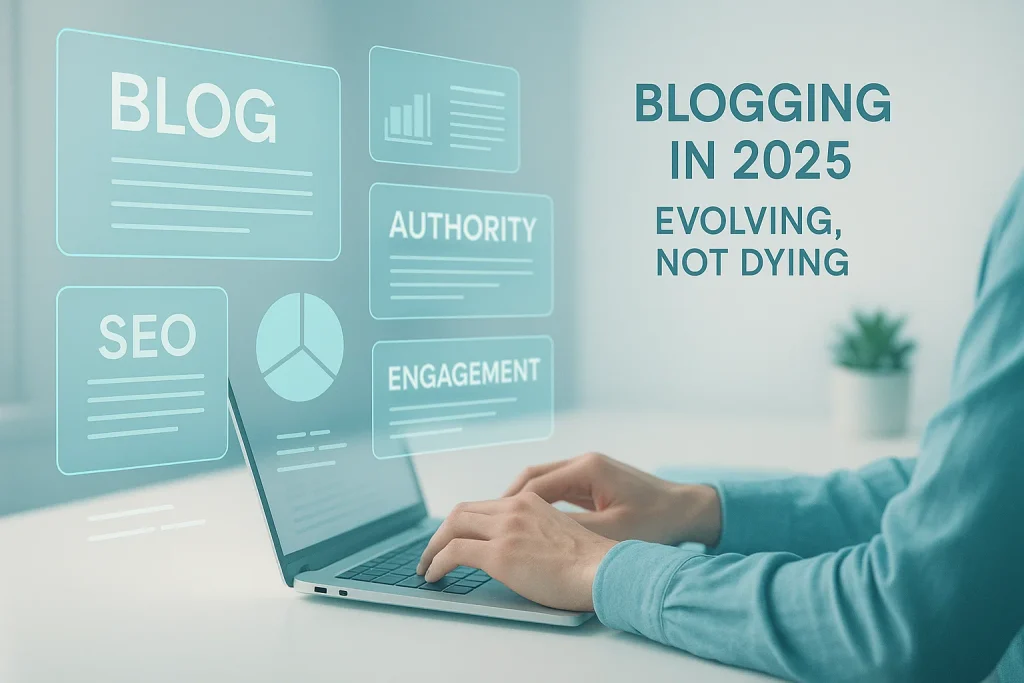In an age of fleeting video clips and endless social media scrolls, a persistent question echoes through the digital marketing world: do people still read blogs?
People no longer just read blogs, they use them. They turn to blog posts for definitive answers, in-depth tutorials, expert analysis, and authentic stories.
These blog articles often act as evergreen resources, guiding readers long after the initial publication date.
With attention spans seemingly shrinking, it’s easy to assume the written word has lost its power. The reality, however, is far more nuanced and optimistic.
Blogging isn’t dead; it has evolved into a more sophisticated and integral component of the digital ecosystem.
The modern blog is a dynamic resource, a hub for authority, and a critical tool for building a loyal audience. Well-crafted blog articles play a key role in showcasing expertise and attracting long-term readers.
This guide explores the state of modern readership in 2025, revealing not only that people still read blogs, but also how to create content that they will actively seek out, consume, and share.
Do People Still Read Blogs?
Yes, Blogging is Thriving and Evolving in 2025. Blogging remains a cornerstone of content marketing and information dissemination.

The difference lies in the how and why people read. The passive consumption of the past has been replaced by active, purpose-driven engagement.
Current Blog Readership Statistics and Trends
Data confirms that blogging is far from obsolete. A staggering 77% of internet users read blogs regularly, demonstrating a continued reliance on this format for information and entertainment.
This isn’t a niche activity; it’s a mainstream behavior. Businesses have taken note, with 90% of them using content marketing tactics like blogging to cultivate their online presence, boost brand awareness and generate leads.
| Metric | 2019 | 2022 | 2025 | Trend Insight |
|---|---|---|---|---|
| % of Internet Users Who Read Blogs | 67% | 73% | 77% | Blog readership remains strong and growing. |
| % of Businesses Using Blogging for Marketing | 78% | 85% | 90% | Blogging is now a core content marketing strategy. |
| Average Blog Post Length (Words) | 1,000 | 1,250 | 1,400–1,500 | Longer, in-depth posts perform better in SEO. |
| Average Time Spent on Blog Page | 2m 10s | 2m 45s | 3m 15s | Readers stay longer on quality, structured content. |
| % of Traffic from Search Engines | 60% | 63% | 68% | SEO continues to drive majority of blog visits. |
| % of Marketers Using AI Tools in Content Creation | 15% | 45% | 90% | AI enhances speed and ideation, not human insight. |
The modern reader actively seeks out high-quality blog posts to solve specific problems, making blogging a powerful tool for connecting with a target audience.
Why the Question Persists: Shifting Content Consumption Landscape
The doubt surrounding blogging’s relevance stems from the undeniable rise of short-form video on social media platforms like TikTok and Instagram. This has conditioned users to consume content in quick, visually-driven bursts.
This shift has certainly changed expectations. Today’s reader has less patience for dense, uninspired walls of text. They demand value immediately. The challenge for bloggers is not a lack of readers, but the increased competition for their attention.
The Enduring Power of Written Content: Why Blogs Remain Relevant
Despite the boom in video content, written content still holds unique advantages. A well-researched blog post, especially as long-form content, allows for a depth of explanation that video often cannot match. It’s the ideal format for complex topics, detailed guides, and nuanced arguments.

Crucially, text-based content is highly favored by search engines like Google. A comprehensive blog, backed by strong search engine optimization (SEO) practices, allows a website to rank for countless keywords and drive organic traffic consistently over time.
It serves as a foundational asset in any serious content marketing strategy, providing the substance that can be repurposed across other channels.
Understanding the Modern Blog Reader’s Journey
To succeed in 2025, you must first understand the modern blog reader. Their journey from discovery to engagement is more complex than ever, driven by specific needs, behaviors, and expectations.

The Psychology of Online Reading: Skimming, Scanning, and Deep Dives
The modern reader is a multi-modal consumer. They typically arrive at a blog post with a specific goal and engage in one of three ways:
- Scanning: The reader’s eyes dart across the page, looking for headings, keywords, and bolded text to see if the content is relevant to their query.
- Skimming: Once relevance is confirmed, they read the introduction, headings, and conclusion to grasp the main points quickly.
- Deep Diving: If the content proves valuable and well-structured, they commit to reading the entire piece, absorbing the details. Your blog post must be structured to cater to all three behaviors simultaneously.
What Drives Engagement: Problem-Solving, Expertise, and Authentic Connection
A reader invests their time in a blog post because they expect a return. Engagement is a direct result of providing value.
This value comes from solving a reader’s problem, offering clear expertise on a subject, or creating an authentic connection through storytelling.
Meaningful engagement isn’t just about page views; it’s about inspiring action, whether that’s leaving thoughtful comments, subscribing to a newsletter, or sharing the content.
The New Discovery Channels: Beyond Traditional Search
While a search engine remains a primary gateway, it’s no longer the only one. Today, blog posts are discovered through a diverse web of channels.
A compelling piece of content might be shared in a niche community forum, linked in an influential newsletter, or surface through curated content platforms.
Social media platforms also play a key role, not just for promotion, but as discovery engines in their own right.
The Demand for Trust: Authenticity in an AI-Enabled World
As AI-generated content becomes more prevalent, readers are placing a higher premium on authenticity and proven expertise. They are looking for a human voice, personal experiences, and a unique perspective that a machine cannot replicate.
A blog is the perfect medium to build this trust. By consistently publishing insightful, well-researched, and genuinely helpful content, you establish your website as a credible authority in a sea of digital noise.
Crafting Content That Resonates: The Modern Blog Post Formula
Creating a successful blog post in 2025 requires a strategic approach that blends classic writing principles with modern design and technology. It’s about delivering substance in a highly accessible format.
The “Skimmable Deep Dive”: Designing for Diverse Attention Spans
The most effective blog posts today follow a “skimmable deep dive” structure. They offer substantial, in-depth information but present it in a way that is easy to navigate.
This involves using clear, descriptive headings, short paragraphs, bullet points, and bold text for key takeaways.
While the average blog post length is around 1,300–1,500 words to satisfy search engine algorithms, its structure must cater to the human reader’s need for clarity and speed.
AI as a Strategic Partner: Enhancing, Not Replacing, Human Creativity
Artificial intelligence is a powerful tool, not a replacement for a skilled writer. As 90% of content marketers plan to use AI in 2025, its role is best defined as a strategic partner.
Use AI for brainstorming ideas, conducting keyword research, and generating outlines. However, the final content – the nuance, storytelling, and expert insight – must come from a human to build trust and connection with your audience.
Beyond Text: Integrating Multimedia for Richer Experiences
Text alone is no longer enough. Integrating multimedia is essential for holding a reader’s attention and clarifying complex information.
According to one study, articles with images receive 94% more views than those without.
Embed relevant videos, create custom infographics, and use high-quality visuals to break up text and make your content more engaging and memorable.
The Unbreakable Foundation: Quality, Value, and Expertise
No amount of formatting or promotion can save poor content. The foundation of any successful blog is an unwavering commitment to quality.
Every post must aim to be the best possible answer to the reader’s question. This requires thorough research, clear writing, and demonstrating genuine expertise on the subject matter.
The most successful blog articles combine these qualities to stand out in competitive niches and earn readers’ trust.
Maximizing Reach: Strategic Distribution and Audience Growth
Writing a great blog post is only half the battle. To ensure it reaches its intended audience, a robust and multi-faceted distribution strategy is essential.
Evolving SEO for 2025: Adapting to Algorithm Shifts
Modern SEO is less about technical tricks and more about user intent. Google’s algorithms are increasingly sophisticated, prioritizing content that thoroughly and clearly answers a user’s query to perform better in search engine results.
This means focusing on comprehensive keyword research to understand what your audience is searching for and structuring your content to provide those answers directly.
Building an Owned Audience: The Power of Email and Community
Relying solely on search engines or social media platforms is risky. The most valuable asset you can build is an “owned” audience – primarily through an email list.
Use your blog to offer valuable content in exchange for an email address. This creates a direct channel of communication that you control, allowing you to nurture leads and build a loyal community around your brand.
Multi-Channel Promotion: Diversifying Beyond Social Media
While sharing your posts on social media is important, effective promotion goes much further. Distribute your content in relevant online communities, forums like Reddit, and on Q&A websites like Quora.
Reach out to other bloggers for guest posting opportunities and collaborate with influencers in your niche to amplify your reach.
Repurposing Content: Maximizing Value Across Formats

A single, well-researched blog post is a goldmine of content. Maximize its value by repurposing it into different formats.
A list-based post can become an infographic. A detailed guide can be broken down into a series of short videos or an email course.
Key statistics can be turned into shareable visuals for Instagram. This strategy extends the life and reach of your core content.
Technical Foundations for a Seamless User Experience
Your content’s performance is directly tied to your website’s technical health. A slow-loading page or a poor mobile experience will cause readers to leave before they even start reading.
Using a reliable platform like WordPress and focusing on core web vitals like site speed and mobile responsiveness is non-negotiable for retaining your audience.
The Enduring Power of Blogs in the Digital Ecosystem
Far from fading into obscurity, blogs have solidified their position as the intellectual backbone of the internet.
They are the primary source for deep, authoritative content that fuels search engines, informs social media conversations, supports affiliate marketing strategies, and builds lasting connections between brands and their audiences.
Adapting to Thrive: Key Takeaways for Modern Bloggers
To succeed in this evolved landscape, bloggers must adapt. The path forward involves:
- Understanding the Reader: Acknowledge their goals and cater to their scanning and deep-reading habits.
- Prioritizing Value: Every post must solve a problem, answer a question, or provide unique insight.
- Embracing Multimedia: Use visuals, videos, and interactive elements to enhance the user experience.
- Distributing Strategically: Move beyond “publish and pray” to a multi-channel promotion and repurposing strategy.
- Building Trust: Double down on human expertise and authenticity as a differentiator in an AI-driven world.
Final Thought
The question is not whether people still read blogs, but whether you are creating a blog that people want to read. The opportunity has never been greater.
By understanding the modern reader’s journey and committing to quality, you can build a powerful content engine that drives traffic, generates leads, and establishes you as a trusted authority. It’s time to stop questioning the relevance of blogging and start embracing its evolution.




